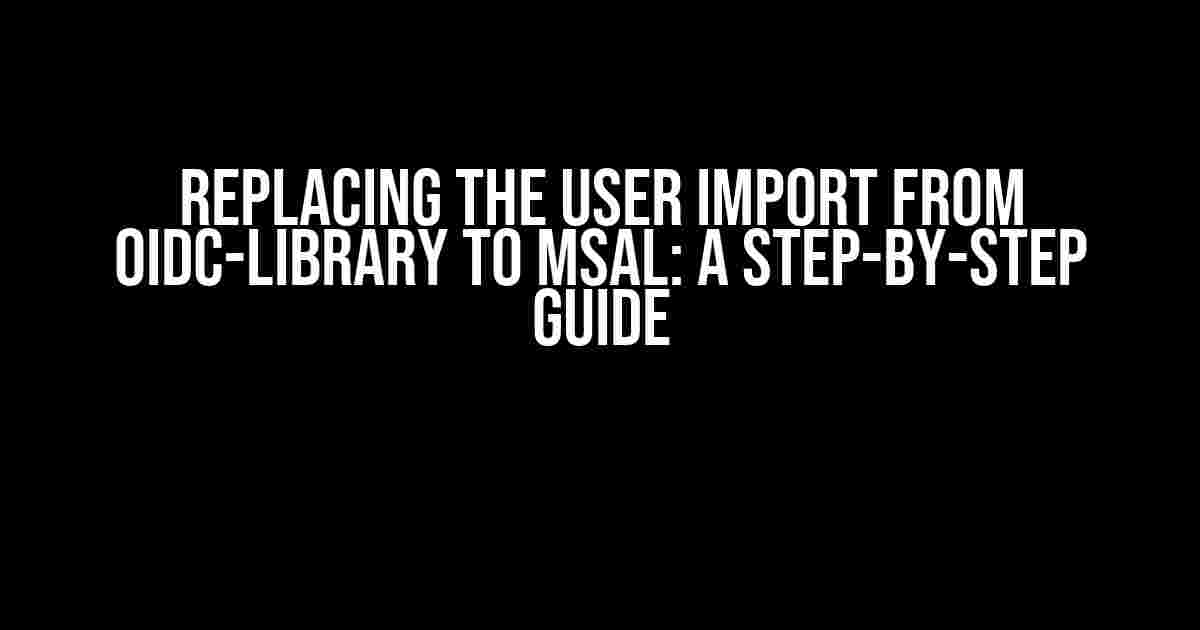Are you tired of using the oidc-library for user authentication and want to switch to Microsoft Authentication Library (MSAL)? Look no further! In this article, we’ll take you through a comprehensive guide on replacing the user import from oidc-library to MSAL. Buckle up and get ready to upgrade your authentication game!
Why MSAL?
MSAL provides a more secure and efficient way of handling user authentication compared to oidc-library. With MSAL, you can:
- Take advantage of the latest security features and best practices
- Enjoy a more streamlined authentication process
- Get better support for Azure Active Directory (AAD) and other identity providers
Before We Begin
Before diving into the replacement process, make sure you have the following:
- A working oidc-library implementation
- A registered Azure AD application
- The MSAL library installed in your project
If you’re new to MSAL, take some time to familiarize yourself with the library and its capabilities. The official MSAL documentation is an excellent resource to get you started.
Step 1: Update Your Import Statements
The first step is to update your import statements to point to the MSAL library. Replace the following oidc-library import:
import { UserManager } from 'oidc-library';With the following MSAL import:
import { PublicClientApplication } from '@microsoft/msal-browser';Step 2: Initialize the MSAL Client
Next, initialize the MSAL client by creating a new instance of the PublicClientApplication class:
const clientApp = new PublicClientApplication(
'your_client_id',
'https://login.microsoftonline.com/your_tenant_id'
);Replace your_client_id with your Azure AD application’s client ID and your_tenant_id with your tenant ID.
Step 3: Configure the MSAL Client
Configure the MSAL client by adding the necessary settings. For example, you can set the redirect URI:
clientApp.setRequestUrl('https://your-app.com/redirect');This will instruct the MSAL client to redirect the user to the specified URL after authentication.
Step 4: Handle User Login
To handle user login, create a function that uses the MSAL client to acquire an access token:
async function login() {
try {
const response = await clientApp.acquireTokenSilent({
scopes: ['https://graph.microsoft.com/.default']
});
if (response) {
console.log('Access token acquired:', response.accessToken);
} else {
console.error('Failed to acquire access token');
}
} catch (error) {
console.error('Error logging in:', error);
}
}This function uses the acquireTokenSilent method to acquire an access token silently, without prompting the user to sign in. If the token is acquired successfully, it will be logged to the console.
Step 5: Handle User Logout
To handle user logout, create a function that clears the MSAL client’s cache and removes any stored tokens:
async function logout() {
try {
await clientApp.logout();
console.log('User logged out successfully');
} catch (error) {
console.error('Error logging out:', error);
}
}This function uses the logout method to clear the MSAL client’s cache and remove any stored tokens.
Step 6: Update Your User Import
Finally, update your user import to use the MSAL client. Replace the following oidc-library code:
import { UserManager } from 'oidc-library';
const userManager = new UserManager({
authority: 'https://your-oidc-authority.com',
client_id: 'your_client_id',
redirect_uri: 'https://your-app.com/redirect'
});
const user = await userManager.getUser();With the following MSAL code:
import { PublicClientApplication } from '@microsoft/msal-browser';
const clientApp = new PublicClientApplication(
'your_client_id',
'https://login.microsoftonline.com/your_tenant_id'
);
const user = await clientApp.getAccount();The getAccount method returns the signed-in user’s account information.
Conclusion
That’s it! You’ve successfully replaced the user import from oidc-library to MSAL. By following these steps, you’ve upgraded your authentication process to use the more secure and efficient MSAL library.
Remember to test your implementation thoroughly to ensure that everything is working as expected. If you encounter any issues or have questions, refer to the official MSAL documentation and the Azure AD troubleshooting guide.
Additional Resources
For more information on MSAL and Azure AD, check out the following resources:
- MSAL Documentation: https://docs.microsoft.com/en-us/azure/active-directory/develop/msal-js-initializing-client-applications
- Azure AD Troubleshooting Guide: https://docs.microsoft.com/en-us/azure/active-directory/develop/troubleshoot-authentication-issues
- Azure AD Code Samples: https://github.com/Azure-Samples/ms-identity-javascript-tutorial
By following this guide, you’ve taken the first step towards a more secure and efficient authentication process using MSAL. Happy coding!
| oidc-library | MSAL |
|---|---|
import { UserManager } from 'oidc-library'; |
import { PublicClientApplication } from '@microsoft/msal-browser'; |
userManager.getUser() |
clientApp.getAccount() |
This table provides a quick reference for replacing oidc-library code with MSAL code.
- Update your import statements to point to the MSAL library.
- Configure the MSAL client by adding the necessary settings.
- Handle user login by acquiring an access token using the
acquireTokenSilentmethod. - Handle user logout by clearing the MSAL client’s cache and removing any stored tokens.
- Update your user import to use the MSAL client.
By following these steps, you’ll be well on your way to replacing the user import from oidc-library to MSAL.
Frequently Asked Question
Got questions about replacing the user import from oidc-library to MSAL? We’ve got the answers!
Why do I need to replace oidc-library with MSAL?
The oidc-library is being deprecated, and Microsoft recommends using the Microsoft Authentication Library (MSAL) for authentication and authorization. MSAL provides more advanced features, better security, and improved performance.
What are the main differences between oidc-library and MSAL?
MSAL provides more advanced token acquisition and management, better error handling, and improved support for conditional access and multi-factor authentication. MSAL also offers more flexibility and customization options for authentication flows.
How do I migrate my existing oidc-library code to MSAL?
Microsoft provides a migration guide and code samples to help you transition from oidc-library to MSAL. You can also use the MSAL migration tool to automatically convert your oidc-library code to MSAL.
Will my existing authentication flow work with MSAL?
Most authentication flows will work with MSAL, but you may need to make some minor adjustments to your code. MSAL provides more flexibility and customization options, so you may need to update your authentication flow to take advantage of these features.
What kind of support does Microsoft offer for MSAL?
Microsoft provides extensive documentation, code samples, and community support for MSAL. You can also open a support ticket or contact Microsoft support for help with MSAL-related issues.




